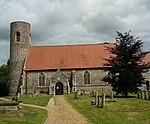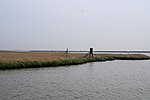Belton and Burgh railway station

Belton & Burgh was a station in the Norfolk village of Belton on the outskirts of Great Yarmouth but also served the village of Burgh Castle about 3.5 km away. It once saw trains on the main line from Yarmouth South Town to London, but was closed in 1959 as part of a major re-evaluation of the British Railways network. It was on a connecting branch between Great Yarmouth and Beccles.The site of the station can still be located. It is now a modern house where Station Road South meets Station Road North. A notable bump in the road signifies where the track once crossed. The station was on the left, travelling north to south, with the house having a "Platform 3" sign hanging by the driveway. On the right, an access road to a camp site is on the old track bed going off towards St. Olaves.
Excerpt from the Wikipedia article Belton and Burgh railway station (License: CC BY-SA 3.0, Authors, Images).Belton and Burgh railway station
Station Road South,
Geographical coordinates (GPS) Address External links Nearby Places Show on map
Geographical coordinates (GPS)
| Latitude | Longitude |
|---|---|
| N 52.56564 ° | E 1.65495 ° |
Address
Belton and Burgh
Station Road South
NR31 9NA , Belton with Browston
England, United Kingdom
Open on Google Maps











